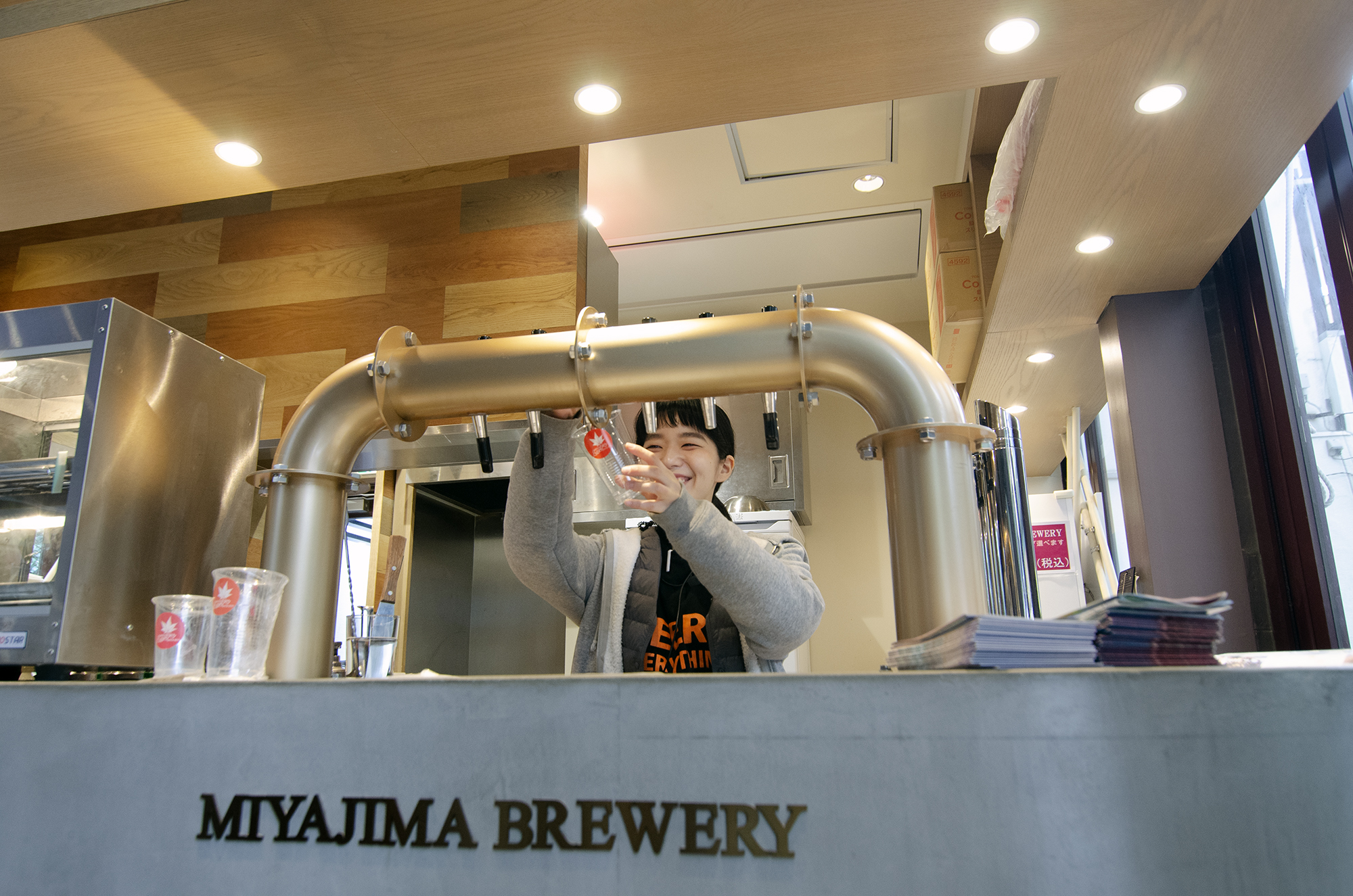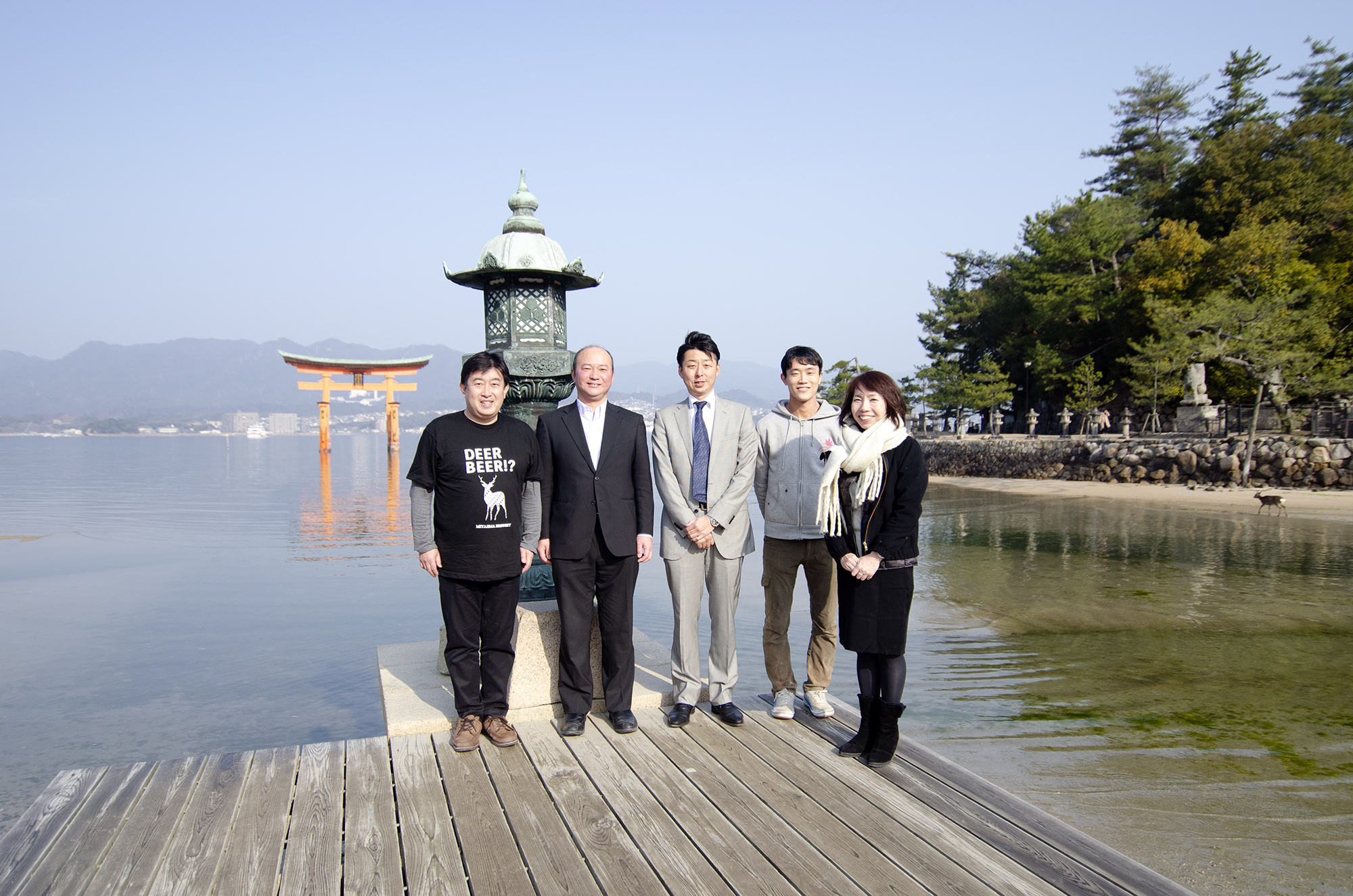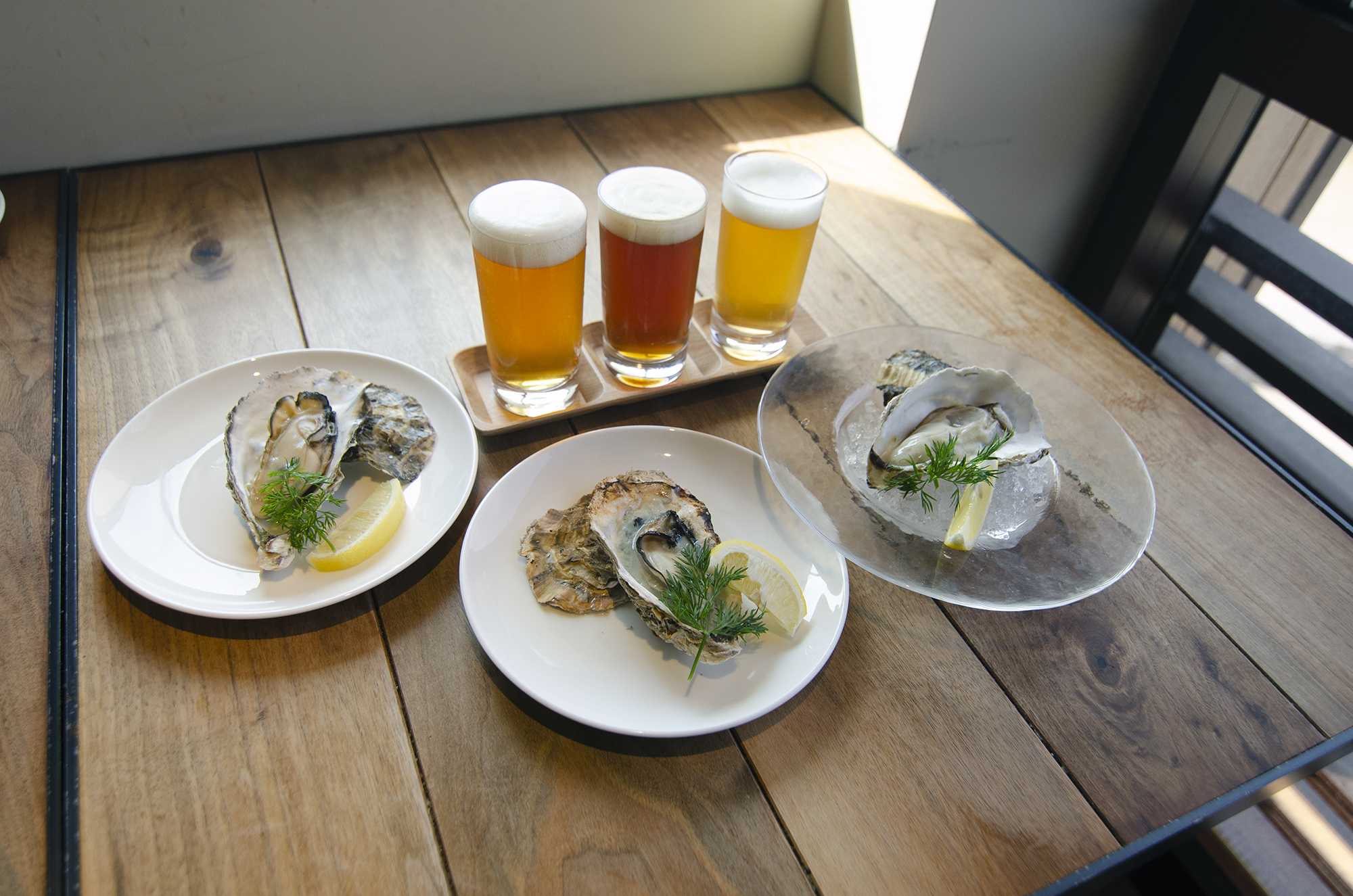
(photos & text by Brian Kowalczyk)
The island of Itsukushima is a special place. It’s wholly protected as a UNESCO World Heritage Site due to what is likely the most well-known symbol of Japan after Mount Fuji: Itsukushima Shrine. Simply doing a photo search on Google for “Japan” will turn up multiple pictures of the iconic vermillion arch that sits in the cove where it beckons all to the 12th-century Shinto holy site. The shrine was painstakingly constructed so as to appear floating on the surface of the ocean at high tide. As nature plays a central role in the Shinto religion, it also was designed to act as a sacred link between the sea and Mount Misen, which rises up steeply in the immediate background. It’s a place of great spirituality and the long-time denizens of the island are inextricably linked to it. Shigeki Arimoto, CEO of Miyajima Beer, is one of those locals.
Arimoto’s ancestors have lived on Miyajima for close to 400 years. The town (merged into Hatsukaichi City in 2005) has become synonymous with Itsukushima Island as the shoreline forms its borders. The northern tip of the island is basically the only inhabited part. It is here that we find Miyajima Beer, the island’s only brewery. I arrive at 9:00am on March 1st to meet Arimoto and his team. As is tradition for business owners here, he begins each and every month with a visit to the Itsukushima Shrine to show appreciation for his success and to pray for future good fortune. Far from simply a mystical concept, the shrine is directly responsible for drawing around four million tourists yearly to the town, providing the lifeblood for local businesses. I join Arimoto and four of his employees as we visit Itsukushima Shrine, then Awashima Shrine (dedicated in part to brewing) and finally Saiwai Shrine (for good fortune and happiness). The Miyajima Beer team says prayers and makes donations at each shrine. It seems a fitting circle–giving back a little to the sites that bring them business.
Arimoto was in line to be the 20th generation proprietor of an inn on the island. But after university he found a stable position at a life insurance company in Tokyo and was reluctant to return. Just prior to that, his father was elected mayor of Miyajima in 1982. Itsukushima Shrine was yet to be chosen as a World Heritage Site–something that would happen in 1996–and the tourism business was a mere fraction of what it is at present. It was a difficult economic period for the town.
In 1989 new safety regulations were passed that disallowed patrons from staying in wooden structures of a certain size without massive safety renovations. Arimoto’s family had no choice but to close their inn. Tearing it down and rebuilding it was an option, but an expensive one, and an especially difficult undertaking during a poor economy. Arimoto was only in his mid-20s, just getting his feet wet in the insurance industry in Tokyo. His father was fully absorbed with his job as mayor trying to improve the situation of the town. Neither had an idea of what to do about the now vacant inn. Then, due to the untimely passing of his father in 1990, the decision was left to Arimoto alone.
Continuing with his career in insurance in Tokyo–and later Fukuoka–was a much better financial option for him than returning to the island without a plan or the wherewithal to do anything with the old inn. Eventually, in 1992 he made the difficult decision to have it torn down and converted to a parking lot. At least in that form it could generate a cash flow.
Arimoto then accepted a position abroad in Sydney, Australia in 1994. During his two and a half years there, returning to Miyajima was not something he considered much. He says, “I was enjoying my job as an insurance agent and my lifestyle at the time. I completely forgot about my property in Miyajima.” But while in Sydney he was struck by a pamphlet for travel to Japan. The picture in the pamphlet was of that famous arch in front of newly minted World Heritage Site Itsukushima Shrine. He was a bit taken by surprise. “I thought to myself, ‘Wow, I really grew up in a wonderful place!’ I felt a great sense of pride for my hometown. I was a bit startled by the fact that I was born and raised in a place that had become one of Japan’s leading tourist destinations. I had no idea that it had become so famous worldwide.” Though he wasn’t aware of it yet, a seed had been planted that would slowly begin to grow into a business idea.
When he entered his 40s he began to feel some guilt about neglecting the property on Miyajima. It troubled him, thinking about the feelings of his grandparents and how 19 generations of ancestors before him had worked the inn where a parking lot now stood. He finally decided something had to be done. Oddly, the final impetus came about as a result of the Lehman shock. As companies worldwide incurred massive financial losses, many had to cut staff. In May of 2009, his company was forced to downsize and he was laid off. He mulled over what to do. He could remain in the industry and seek employment in Tokyo, but the uneasy feeling that he was insulting his ancestors kept gnawing at him.
He recalled that pamphlet in Sydney and how stunning the scenery was. A thought came to him. Wouldn’t it be great to sit in front of that fabulous view drinking beer? At the time, his uncle was running the Miyajima Grand Hotel, the largest on the island, and his father’s cousin was running another hotel called Kinsuikan. He presented his idea of selling beer to them. Like many inn owners, they were having difficulties managing their places in the face of stiff competition from large corporations with deep pockets. Also at the time, many ji-biru (local microbrewery) businesses were closing their doors, including Bekken Beer in Miyoshi, Hiroshima. Worried that he was destined for failure, they advised him to forget about selling beer and find a job in Tokyo.
But Arimoto was determined. He says passionately, “This lit a fire in me! I absolutely had to do something to help my hometown. My thought was that if people drink beer here, they may opt to stay overnight on the island. Beer lovers from places like Tokyo or Osaka could come for the beer (and the shrine!) and stay the night. I decided that I was going to get involved in the beer business.” It may seem a little naive, but Arimoto was not going to be deterred.
In 2009, with everyone he knew opposed to his idea, he moved forward with it. He began to contract-brew at Niigata Beer. Initially he was laughed at because his “local” Miyajima Beer was being made in Niigata. “I was 44 then and didn’t really pay attention to the chatter. I just said, ‘To hell with it, I’m doing this!’” In March of 2010 he set up a tent to sell beer in his parking lot. For the first two years it was just him and his mother selling draft along with shaved ice added in the summer months.
Tourism numbers were on the steady increase and about 3.2 million people visited the island that year, but beer sales started off slow. There were big lulls seasonally in business, and group tours moved right past his tent on their way to the shrine. He began to think if he had an attractive building there he could do better business. In 2014 he got a very fortuitous call from Starbucks. His property was in a key location a stone’s throw from Itsukushima’s famed gate. The company was very interested in leasing his property. He decided to work with them to erect a building, half of which would be used by his soon-to-be tenant. The other half would become his beer stand, restaurant and eventually, brewery.
In 2012, Arimoto’s first head brewer, veteran Tomohiro Shimura (since moved on), previously of Miyoshi Bekken beer, joined. The beer shifted from being more of a souvenir beer to a craft one. In November of 2017 the building housing Starbucks and Miyajima Beer was finally opened to the public after a protracted construction approval process due to its proximity to a World Heritage Site. Though he obtained the brewing license in January of 2018, due to a variety of trouble with equipment, brewing activities had to wait many more months before getting underway.
Current brewer Tatsuya Morikawa is relatively new to the craft beer world. He joined the company in October of 2017 and has been attending seminars while accumulating hands-on experience under Shoji Kobatake of the Bingo Fukuyama Brewing College. The two men were responsible for setting up all of the equipment in the brewery. On-site brewing commenced in September of 2018 and, thanks in part to Kobatake’s guidance and recipe formulation, Morikawa has quickly blossomed in the role. The company also had the help of a Hungarian brewer named György Dernyey, who spent about a year in Miyajima on working holiday. Miyajima’s IPA (ABV-6.0, IBU-35) is a recipe he created and brewed with Morikawa.
In addition to the IPA, the company’s regular lineup includes Momiji (Japanese maple) Ale (IBU-30, ABV-5.0), a red ale with a malty aroma and taste, and a prominent bitterness. Momiji manju (a maple leaf-shaped cake filled with red bean paste) is one of the most popular items sold on the island and hence, the name and color choice. Miyajima’s Weizen (IBU-8, ABV-5.0) has an especially strong banana aroma and a light body. As oysters are the cash-crop of Hiroshima, you should make a point of trying the Oyster Stout (IBU-33, ABV-5.0), made with smoked oysters and their shells. Pale Ale and Pilsner round out the regulars. There are a variety of seasonals as well, including a new one to be made with kumquats grown by Arimoto’s mother. That one should be released right around the publication of this article. Another beer in planning stages will use Hiroshima-grown blood oranges. Miyajima Beer is sold mainly on the island, in Hiroshima City and at a few locations in Tokyo such as the Hiroshima Prefecture antenna shop in Ginza, and some Hiroshima-style okonomiyaki shops.
Most of the company’s kegged beer is now made on the island while canned and bottled beer continues to be contract brewed at various craft breweries for the time being. The end goal is to eventually make everything 100% locally. Miyajima Beer’s 500L brew system and eight 500L tanks take up all the space in the compact brewery. Space on the island is at a premium and there is no room to expand the current location. Arimoto has already begun planning a larger facility across the bay on the mainland portion of Hatsukaichi City. It will take some years to come to fruition, but he has proven to have significant patience and determination.
When asked if he has any other major plans on the horizon, he has a response that probably shouldn’t surprise considering where he grew up. “I want to make a ‘beer for peace’. My mother was a hibakusha (survivor of the atomic bombing). She was three years old at the time of the blast. So, in the name of world peace, I want to produce a special canned beer that’ll probably make use of Hiroshima oysters.” His goal is to export it to the US and Europe, and donate the profits to appropriate charities.
If you take a trip to Miyajima, do yourself a favor–don’t just snap some photos of the world-famous shrine, buy some souvenir momiji manju, and catch the next ferry back to the mainland. There is so much more to see and do. The ancient Shinto priests constructed their shrine here with good reason. The sights of the island are a photographer’s dream and climbing Misen is an endeavor well worth the effort. Post-hike, stop by Miyajima Beer to relax and reward yourself with beers and some great food. Consider an overnight stay at one of the island’s attractive inns to complete your experience and put a smile on Arimoto’s face. While he didn’t succeed at becoming the 20th-generation proprietor of the family inn, he has surely made his ancestors proud as an ambassador of Miyajima. And judging by the stream of customers visiting his establishment on a weekday afternoon in March, no one is laughing now at his idea of selling local beer to thirsty tourists.
(Team Miyajima Beer (Arimoto, Oki, Arai, Morikawa, Ota)

This article was published in Japan Beer Times # () and is among the limited content available online. Order your copy through our online shop or download the digital version from the iTunes store to access the full contents of this issue.




